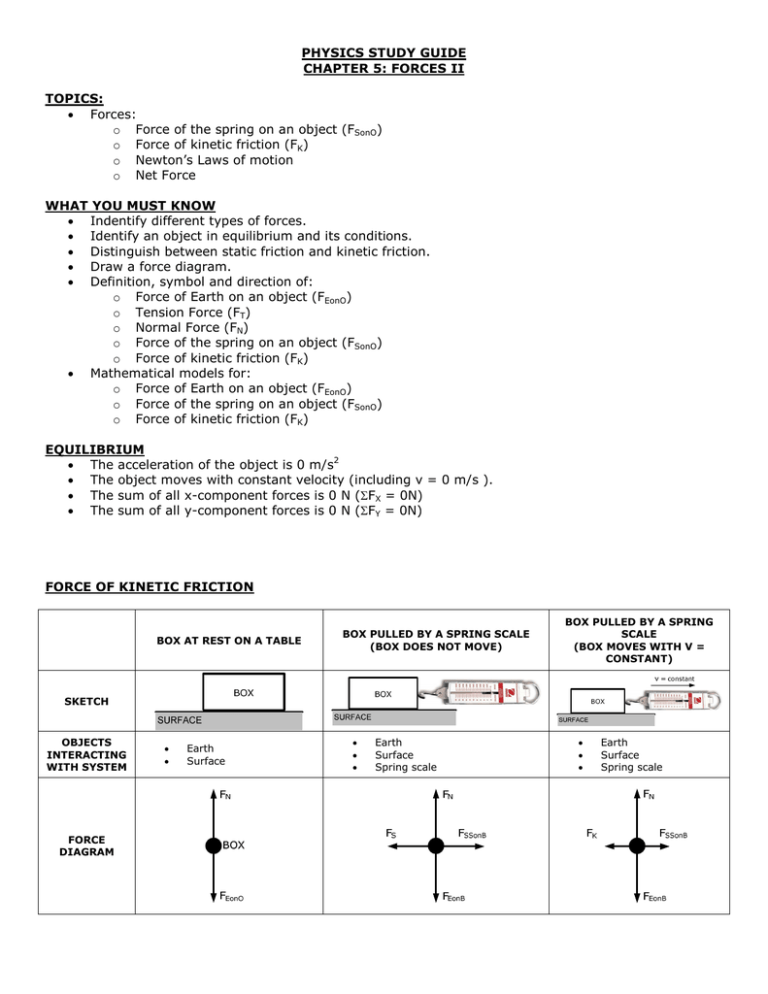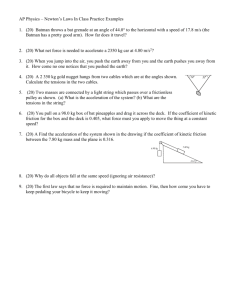PHYSICS STUDY GUIDE CHAPTER 5: FORCES II TOPICS:
advertisement

PHYSICS STUDY GUIDE CHAPTER 5: FORCES II TOPICS: • Forces: o Force of the spring on an object (FSonO) o Force of kinetic friction (FK) o Newton’s Laws of motion o Net Force WHAT YOU MUST KNOW • Indentify different types of forces. • Identify an object in equilibrium and its conditions. • Distinguish between static friction and kinetic friction. • Draw a force diagram. • Definition, symbol and direction of: o Force of Earth on an object (FEonO) o Tension Force (FT) o Normal Force (FN) o Force of the spring on an object (FSonO) o Force of kinetic friction (FK) • Mathematical models for: o Force of Earth on an object (FEonO) o Force of the spring on an object (FSonO) o Force of kinetic friction (FK) EQUILIBRIUM • The acceleration of the object is 0 m/s2 • The object moves with constant velocity (including v = 0 m/s ). • The sum of all x-component forces is 0 N (ΣFX = 0N) • The sum of all y-component forces is 0 N (ΣFY = 0N) FORCE OF KINETIC FRICTION BOX AT REST ON A TABLE BOX PULLED BY A SPRING SCALE (BOX DOES NOT MOVE) BOX PULLED BY A SPRING SCALE (BOX MOVES WITH V = CONSTANT) SKETCH OBJECTS INTERACTING WITH SYSTEM FORCE DIAGRAM • • Earth Surface • • • Earth Surface Spring scale • • • Earth Surface Spring scale Surfaces exert two types of forces: • FN (Normal Force): Force exerted by any surface that supports an object. Perpendicular ⊥ to the surface • FS (Force ok static friction): Force exerted by any surface that supports an object. Parallel to the surface when the object is NOT in motion. • FK (Force ok kinetic friction): Force exerted by any surface that supports an object. Parallel to the surface when the object is in motion and OPPOSING the motion of the object. EQUILIBRIUM AND FORCE OF KINETIC FRICTION: • • • • If you know the mass of the object you can find the force of Earth (weight) If you know the force of Earth, then you immediately know the normal force (and vice versa). If you know the force exerted on the object, then you know the force of kinetic friction (and vice versa). You can also find the force of kinetic friction if you have physical quantities such the normal force and the coefficient of kinetic friction. PHYSICAL QUANTITIES Normal Force: • Definition: Force exerted by any surface that supports an object. • Symbol: FN • Direction: Always perpendicular to the surface (90° angle) • Units: N (Newtons) Coefficient of kinetic friction • Definition: o Ratio between two forces FK & FN. o Slope of the FK vs. FN graph • Symbol: µK • Units: (no units) Force of kinetic friction: • Definition: Force exerted by any surface that opposes the motion of the object. • Symbol: FK • Direction: Always parallel to the surface (0° angle) • Units: N (Newtons) • • • • • The slope of the FK vs. FN graph is the coefficient of kinetic friction. One diagonal straight line has only one slope; therefore there is only one coefficient of kinetic friction between two surfaces. The coefficient of kinetic friction is a property between TWO surfaces. The coefficient of kinetic friction is a ratio between two forces FK & FN. The coefficient of kinetic friction is a number with no units between 0 and 1. FORCE OF THE SPRING ON AN OBJECT BANANAS HAN GING AT THE BOTTOM OF A SPRING SCALE OBJECTS INTERACTING WITH THE SYSTEM FORCE DIAGRAM Earth SKETCH Spring scale EQUILIBRIUM AND FORCE OF THE SPRING ON AN OBJECT: • • • If you know the mass of the object you can find the force of Earth (weight) If you know the force of Earth, then you immediately know the force of the spring (and vice versa). You can also find the force of the spring on an object if you have physical quantities such as elongation and spring constant. PHYSICAL QUANTITIES Elongation • Definition: How much a spring stretches or compresses beyond its relaxed length. • Symbol: ∆L • Units: meters (m) Spring Constant Definition: Force needed to stretch a spring by one meter. Slope of the FSonO vs. ∆L graph Symbol: k Units: N/m Force • • • • • • • • • of a spring on an object: Definition: Force exerted by a spring on any object. Symbol: FSonO Direction: Always in the direction of the spring. Units: N (Newtons) The slope of the FSSonO vs. ∆L graph is the spring constant. One diagonal straight line has only one slope; therefore there is only one spring constant for each spring. The spring constant is a property of a spring. The spring constant is the force required to stretch a spring one meter ( 1 m ). The spring constant friction can be a big number with units N/m. NEWTON’S FIRST LAW OF MOTION • Unless an unbalanced force is exerted on an object. The object will continue moving with constant velocity. NEWTON’S SECOND LAW OF MOTION • The acceleration of an object is directly proportional to the acceleration of the object. • The acceleration of an object is inversely proportional to the mass of the object. Newton’s second law is a cause/effect relationship because an unbalanced force will cause an acceleration (no the other way around). • Mathematical model: Mass • Definition: amount of matter in an object. • Symbol: m • Units: kilograms (kg) Acceleration • Definition: o How much the velocity changes in an unit of time • Symbol: a • Units: m/s2 Net Force: • Definition: Sum of all objects exerted on an object. • Symbol: ΣF • Direction: Always in the direction of the unbalanced force • Units: N (Newtons) NEWTON’S THIRD LAW OF MOTION • When two objects interact, object A exerts a force on object B. In turn, object B exerts a force on object A. • These two forces are equal in magnitude, but opposite in direction. Action reaction is not the best definition of Newton’s third law of motion because it does not specify that: • Forces are exerted on two different objects. • Forces are equal in magnitude, opposite in direction. NET FORCES • Objects in equilibrium: ΣF = m · a = 0 N • Objects NOT in equilibrium: ΣF = m · a o If the direction of the net force is negative then: ΣF = - m · a
